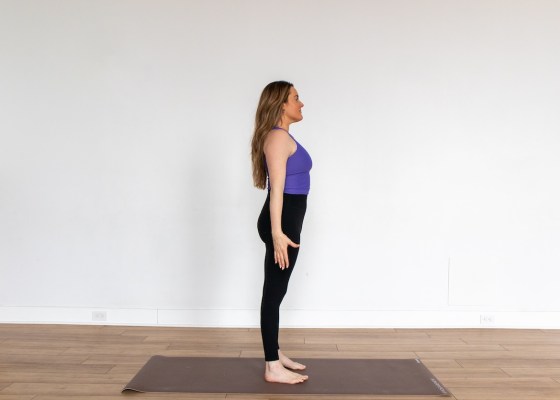Want to Age Well? These 8 Yoga Poses Improve Balance, One of the Most Important Elements of Longevity
Some of these may already be staples in your practice.
You’re never too young to prioritize balance training. It may enhance memory and spatial cognition, lower the risk of injury in athletes, and improve postural control, the latter of which contributes to better motor performance in sports. One way to get your fill: Incorporate yoga poses for balance into your movement routine.
A 2022 study in the Slovenian Journal of Public Health found that practicing 30 minutes of yoga a day for four weeks led to improvements in static, dynamic, and overall balance in older adults.
Ahead, learn exactly why the movement practice can give your stability a boost and discover the best yoga balance poses to challenge and improve it, according to a pro.
First things first: How does yoga help with balance?
There are a few key elements that make yoga a balance-enhancing practice, says Kate Lombardo, RYT-200, yoga teacher and yoga director of YogaRenew. At its core, yoga is a barefoot activity, and many of the poses are performed while standing. You end up paying plenty of attention to your feet—the base of the postures—and the specific ways they’re supporting you in space, Lombardo says.
As you settle into chair pose (Utkatasana), for instance, you’ll realize you’re holding a good portion of your body weight in your heels. In a standing forward fold (Uttanasana), you’ll notice your weight is primarily in your toes, as the goal is to stack the hips directly over the ankles, Lombardo explains.
“We live so much of our lives in shoes nowadays, and they’re not necessarily great for our foot muscle development,” Lombardo says. “Yoga is a really good way to counteract that; it improves the use of your feet and your toes, which is directly related to balance…If we can get our feet to work really well, that helps us set everything from the ground [up].” It’s just like a house: If the foundation’s rickety, the entire home will be out of balance, she adds.
Regardless of the posture, yoga can improve proprioception—the ability to sense where your body is positioned in space—and mind-body connection, Lombardo says. (This is backed up by a 2023 systematic review in Yoga Mimamsa.) It also enhances core strength and stability and overall flexibility and mobility, a combination of characteristics that support balance, she notes.
Core stability training can improve balance, according to a small 2018 study in Acta of Bioengineering and Biomechanics. As such, it’s been recommended to be a fall prevention measure for older adults, per a small 2015 study in The Journal of Physical Therapy Science.
“All of [the core] needs to be strong [for balance], but also…if we’re so stiff and there’s no movement, as we go throughout our lives, we can fall from that, too,” Lombardo says. “There is a balance in yoga between the strength and flexibility piece, and the mobility part is really important, too. The focus on spinal mobility gives us the practice to be able to move, to sway back and forth a little bit. In doing that with intentionality in yoga, that allows for us to find better balance in our lives.”
“You don’t have to go for the most challenging version of a pose to be able to work on the elements in the body that will build the strength and the flexibility needed to find balance.” —Kate Lombardo, RYT-200
The best yoga balance poses to add to your practice
To kick off your journey to better stability, incorporate the below postures into your practice, as demonstrated by Lombardo. Aim to hold each yoga pose for balance for 5 to 10 breaths, Lombardo suggests. “As you build confidence, you can extend the time to 15 to 20 breaths to really challenge your body and balance,” she says.
1. Mountain pose (Tadasana)
Mountain pose may not look like much of a balance posture, but it’s beneficial to start your practice with.
“That [posture] is the key to standing straight and tall, to understand our body and space,” Lombardo says. “I think if we can understand how to ground both feet fully into the earth, into your mat, into the floor, that’s where we can build that foundation [for balance].”
- Stand tall with your feet hip-width apart, your arms hanging at your sides, and your palms facing inward.
- Roll your shoulders down and back. Your shoulders, hips, and ankles should be stacked.
- Press all four corners of your feet into the ground and gaze forward. Hold this position, continuing to breathe.
- Hold this pose for 5 to 10 breaths.
2. Tree pose (Vrksasana)
This single-leg yoga balance pose can be easily adapted to any experience level. To do tree pose, start with tiptoes resting on the floor, then place your foot on your shin a few inches above the floor, and finally advance by placing your foot on your thigh, Lombardo suggests.
- Stand tall with your feet hip-width apart, your arms hanging at your sides, and your palms facing inward.
- Roll your shoulders down and back. Your shoulders, hips, and ankles should be stacked.
- Press all four corners of your feet into the ground and gaze forward.
- Shift your body weight into your left leg and lift your right foot off the floor.
- Then, place the bottom of your right foot on the inside of your left thigh, your right knee pointed out toward the side, and your right toes positioned above your knee.
- Sweep both of your arms up toward the ceiling, your biceps in line with your ears. Gaze toward the ceiling.
- Hold this position, continuing to breathe.
- Hold this pose for 5 to 10 breaths. Switch sides; repeat.
3. Warrior III (Virabhadrasana III)
This warrior variation, which works your core strength, is one of the more challenging yoga poses for balance. But it can be made more accessible by performing it while resting your hands on a wall, Lombardo says.
- Stand tall with your feet hip-width apart, your arms hanging at your sides, and your palms facing inward.
- Roll your shoulders down and back. Your shoulders, hips, and ankles should be stacked.
- Press all four corners of your feet into the ground and gaze forward. Sweep both of your arms up toward the ceiling, your biceps in line with your ears.
- Shift your body weight into your right leg and lift your left foot off the floor. Keeping your arms raised and right leg straight, hinge forward at your hips, allowing your chest to lower toward the floor in front of you and your left leg to extend and raise behind you.
- Continue hinging forward until your chest is parallel with the floor, or as far as comfortable. Your left leg should be lifted as high as comfortable, your body forming a straight line from fingertips to heel. Hold this position, continuing to breathe.
- Hold this pose for 5 to 10 breaths. Switch sides; repeat.
4. High lunge pose (Utthita Ashwa Sanchalanasana)
As you age, injuries often happen when your two feet are out of alignment, such as when you’re walking, running, or climbing up stairs, Lombardo says. But practicing a high lunge—and building strength and balance in that off-set position—will help prep your body for those daily moments.
- Stand tall with your feet shoulder-width apart, your arms hanging at your sides, and your palms facing inward.
- Roll your shoulders down and back. Your shoulders, hips, and ankles should be stacked.
- Press all four corners of your feet into the ground and gaze forward.
- Take a big step forward with your left leg, allowing your right leg to fully straighten. Your right heel is lifted and your toes are pressing into the ground.
- Keeping your right leg straight, slowly lower into a lunge, bending your right knee to a roughly 90-degree angle.
- Sweep both of your arms up toward the ceiling, your biceps in line with your ears. Gaze toward your fingertips. Hold this position, continuing to breathe.
- Hold this pose for 5 to 10 breaths. Switch sides; repeat.
5. Standing forward fold (Uttanasana)
The forward fold may be a bit surprising to see on a list of yoga poses for balance, but it’s more beneficial than you think. Because your head and torso are positioned below your waist in the posture, you need to rely heavily on your legs and feet to hold your balance, Lombardo says.
- Stand tall with your feet hip-width apart, your arms hanging at your sides, and your palms facing inward.
- Roll your shoulders down and back. Your shoulders, hips, and ankles should be stacked.
- Press all four corners of your feet into the ground and gaze forward.
- Keeping your back flat and legs straight but not locked, hinge forward at your hips, allowing your hands to lower toward the floor in front of you and your chest to lower toward your thighs.
- Continue hinging forward as far as comfortable.
- Then, hold this position, continuing to breathe.
- Hold this pose for 5 to 10 breaths.
6. Chair pose (Utkatasana)
This yoga pose for balance forces you to hold your body weight in your heels, then activate your quads to sit back into the “chair” without falling, Lombardo says. The lower you sit, the more of a balance challenge the posture offers.
- Stand tall with your feet and legs glued together, your arms hanging at your sides, and your palms facing inward.
- Roll your shoulders down and back. Your shoulders, hips, and ankles should be stacked. Gaze forward.
- Keeping your back flat and legs glued together, sit back into your hips, bending your knees and lowering into as deep of a squat as comfortable.
- Sweep both of your arms up toward the ceiling, your biceps in line with your ears. Gaze toward the floor in front of you. Your body should form a straight line from your fingertips to your glutes. Hold this position, continuing to breathe.
- Hold this pose for 5 to 10 breaths.
7. Half moon pose (Ardha Chandrasana)
Like warrior III, this yoga pose for balance is ideal to practice with a wall or a yoga block; you’ll still have a stability challenge from lifting one of your legs off the floor, but you’ll be able to use the props for support as you progress, Lombardo says. Make sure you reach your front arm forward enough to counterbalance the lift of your back leg, she notes.
- Place a yoga block toward the front of your mat. Stand tall at the back of your mat with your feet shoulder-width apart, your arms hanging at your sides, and your palms facing inward. Roll your shoulders down and back. Your shoulders, hips, and ankles should be stacked.
- Press all four corners of your feet into the ground and gaze forward. Take a big step forward with your right leg, allowing your left leg to fully straighten.
- Keeping your left leg straight, slowly lower into a lunge, bending your right knee to a roughly 90-degree angle. Hinge forward at your hips and place both of your hands on either side of your right foot. Gaze toward the floor.
- Place your left hand on your left hip or outer thigh, then reach your right hand forward, placing it on top of the yoga block.
- Keeping your right hand on top of the yoga block, slowly shift all of your body weight into your right leg and lift your left foot off the floor. Continue lifting your left leg up toward the ceiling until it’s aligned with your left hip. Flex your left foot.
- Press through all four corners of your right foot. Your right wrist should be aligned with your right shoulder. Use the block to keep your torso lifted.
- Then, reach your left arm up toward the ceiling, stacking it with your left shoulder. Open your torso toward the left side, allowing your gaze to follow. Hold this position, continuing to breathe.
- Hold this pose for 5 to 10 breaths. Switch sides; repeat.
8. Wide-legged forward fold (Prasarita Padottanasana)
If the standing forward fold feels too challenging, try a wide-legged version instead. The wide stance involved in this yoga pose for balance provides a broader base of support, and you won’t need as great of core and leg muscle engagement to stay stable, Lombardo says.
“Additionally, in the wide-legged version, your center of gravity is lower and the shape allows for a more even weight distribution between the feet, making it easier to find balance,” she adds. “Whereas with the feet together, you have to work harder to centralize your weight over both feet.”
- Stand tall with your feet spread as wide as possible, your arms hanging at your sides, and your palms facing inward.
- Roll your shoulders down and back. Your shoulders and hips should be stacked.
- Press all four corners of your feet into the ground and gaze forward.
- Keeping your back flat and legs straight but not locked, hinge forward at the hips, allowing your hands and head to lower toward the floor in front of you and your chest to lower toward the space in between your thighs.
- Continue hinging forward as far as comfortable.
- Then, hold this position, continuing to breathe.
- Hold this pose for 5 to 10 breaths.
“I think sometimes people think of balancing as only being on one foot, and I think that’s not true. Yoga teaches us that balancing is involved in all these types of movements.” —Kate Lombardo, RYT-200
Safety tips to consider when practicing balancing poses
When practicing yoga balance poses as a beginner, Lombardo recommends first attending a class or working with an instructor virtually. A teacher will ensure that you’re performing each posture with proper alignment, which is essential to maintaining balance and reducing the risk of injury, she says.
To minimize the chances of falling, use props to your advantage. When you first try out the postures, you might place one hand on a yoga block while performing a lunge or on the wall while doing warrior III, Lombardo says.
Also of note: Progress at your own pace. “You don’t have to go for the most challenging version of a pose to be able to work on the elements in the body that will build the strength and the flexibility needed to find balance,” Lombardo says.
It sounds strange, but if you notice yourself beginning to topple over, embrace it. “When we try to fight against the fall completely, then the fall gets worse,” making you more likely to injure yourself, Lombardo says. Instead, if you start to feel unstable during tree pose, for example, put your foot down for a second, take a breath, then come back into it. Being okay with being imperfect is essential to practicing balance yoga poses safely, according to Lombardo.
FAQ
1. What type of yoga is used to develop stability and balance?
In both Hatha and Vinyasa yoga, you’ll move through plenty of active standing, balancing postures, Lombardo says. Many of the poses are the same between the two styles.
However, a Hatha practice will be more static, allowing you to hold the balance poses for a longer time, and a Vinyasa practice will flow more quickly, she says.
If you’re a true beginner, Lombardo suggests starting with a Hatha-style practice, giving you the opportunity to focus on alignment and spend more time on each pose.
2. Why do I struggle with balance in yoga?
There’s no single reason maintaining your balance during yoga feels challenging; being short on core strength, flexibility, mobility, and proprioception may all play a role. You might also struggle with balance if you’re flowing through your practice too quickly or while distracted, Lombardo adds.
“A big piece of balance is mental, too, and it’s the idea of being present and focusing on one thing that can help us to stay balanced—emotionally but also from a physical perspective,” she says.
3. Does yoga help seniors with balance?
Yoga can improve balance in individuals over age 65, a 2022 study in the Slovenian Journal of Public Health suggests.
But regardless of your age, yoga can be used to help you improve your balance, Lombardo says. Many balance-improving postures are even performed with two feet on the ground, reducing the risk of injury for younger and older individuals alike.
“When I first started practicing yoga, a huge balance issue for me was warrior II and triangle pose; your feet are much wider than how you would normally stand in life,” says Lombardo. “…I think sometimes people think of balancing as only being on one foot, and I think that’s not true. Yoga teaches us that balancing is involved in all these types of movements.”
Recommended Story For You :

The alpine secret for healthy weight loss

The Most Potent Fast-Acting Formula For Incinerating Stubborn Fat

Real Cortexi Users Real Life‑Changing Results

This Cold Drink Might Trigger Your Prostate

Red Boost is a powerful new formula for boosting male sexual health.

Everything you eat or drink eventually reaches your liver for processing.

Brand New Probiotics Specially Designed For The Health Of Your Teeth And Gums

Empowering You to Take Control of Your Blood Sugar Health!

Scientists Finally Discover the Root Cause of Belly Fat and Unexplained Weight Gain


